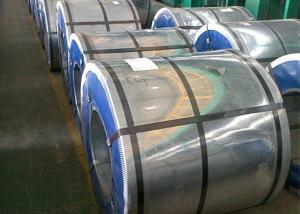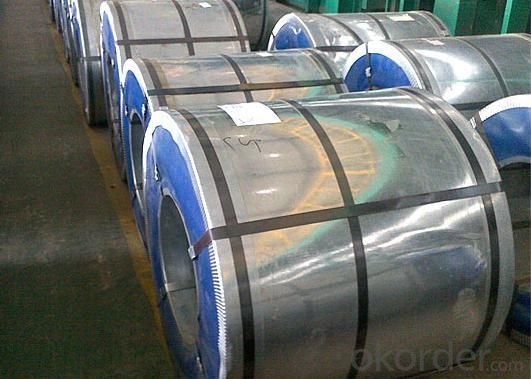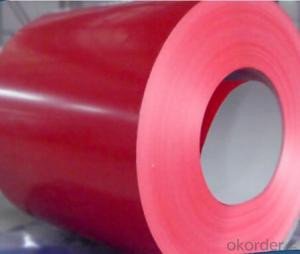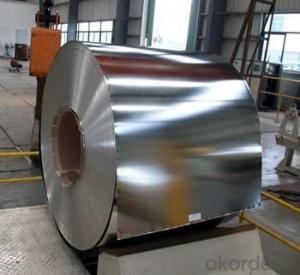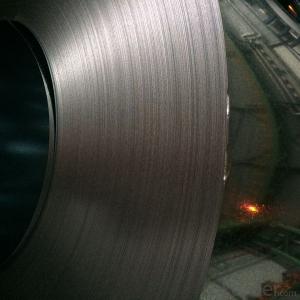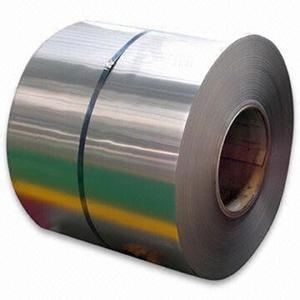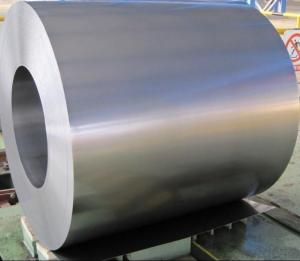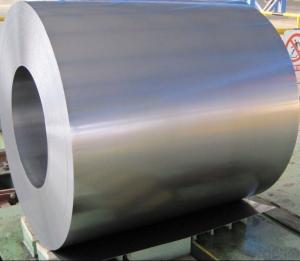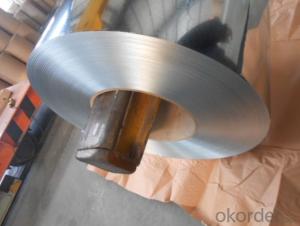Hot Dip Galvanized Steel Coil-Zero Spangle-FORWARD-30-200g/m2
- Loading Port:
- Tianjin Port
- Payment Terms:
- TT or LC
- Min Order Qty:
- 50mt m.t.
- Supply Capability:
- 5000 tons per month m.t./month
OKorder Service Pledge
OKorder Financial Service
You Might Also Like
Hot Dip Galvanized Steel Coil-Zero Spangle-FORWARD-30-200g/m2
Hot-dip galvanized steel coils are available with a pure zinc coating through the hot-dip galvanizing process. It offers the economy, strength and formability of steel combined with the corrosion resistance of zinc. The hot-dip process is the process by which steel gets coated in layers of zinc to protect against rust. It is especially useful for countless outdoor and industrial applications.
Product Description Of Hot Dip Galvanized Steel Coil- Zero Spangle - FORWARD- 30- 200g/m2
|
Thickness |
0.13mm-0.7mm |
|
Width |
600mm-1250mm |
|
Zinc Coating |
30-200g/m2 |
|
Internal Diameter |
508mm/610mm |
|
Coil Weight |
3-12MT |
|
Quality |
commercial and structural quality |
|
Surface Treatment |
regular & minimum spangle, zero spangle, oiled & dry, chromated , non-skin pass , skin pass |
|
Standard |
JIS G 3302, ASTM A 653M, EN 10327 |
|
Steel Grade |
SGCC, CS, FS, SS, LFQ, DX51D+Z , S280GD |
Technical Data Of Hot Dip Galvanized Steel Coil- Zero Spangle - FORWARD- 30- 200g/m2
|
Chemical Composition |
C |
Si |
Mn |
P |
S |
|
0.04-0.06% |
0.01-0.03% |
0.18-0.22% |
0.014-0.016% |
0.006%-0.009% |
|
Yield Strength |
(Mpa) 280-320 |
|
Tensile Strength |
(Mpa) 340-390 |
|
Elongation |
20%-30% |
|
Out-of-square |
not exceed 1% Flatness |
|
Bow |
15mmmax |
|
Edge Wave |
9mmmax |
|
Centre Buckle |
8mmmax |
|
Bending At 180 Degree |
No crack, purling and fraction |
Application Of Hot Dip Galvanized Steel Coil- Zero Spangle - FORWARD- 30- 200g/m2:
It can be widely used in transportation, light industry, civil usage and farming. It is also the perfect building material in construction for making roofing tile, steel profiles for wall partition, T-bar, studs, fireproof door, air conditioning duct and home appliance.

Packaging & Delivery Of Hot Dip Galvanized Steel Coil- Zero Spangle - FORWARD- 30- 200g/m2:
The packing of coils consists of anti-damp paper, PVC film, hardboard paper, steel box, strapped with steel strips, fitted with locks and edge protectors and guarantees the optimal condition of the delivered goods. Each coil can be additionally fitted with wooden/steel skids(eye to the side) or wooden pallets(eye to the sky).


Production Flow Of Hot Dip Galvanized Steel Coil- Zero Spangle - FORWARD- 30- 200g/m2:
Production flow of hot dip galvanized steel coil - zero spangle - forward - 30 - 200g/m2 include dual uncoiler, stitcher(welder), bridle, steering unit, entry accumulator, heating & soaking furnace, jet cooling section, ceramic zinc port, cooling tower, skin pass mill, tension leveller, chromating with dryer, exit accumulator and dual recoiler.
- Q: Does steel contain nickel?
- Stainless steel is a steel than contains at least 10% chromium. But there are many nuance of stainless steel, with different composition for various applications, and some do contain nickel. But not all types of stainless steel contain nickel.
- Q: How are steel coils used in the manufacturing of structural components?
- Steel coils are used in the manufacturing of structural components by being processed through various techniques such as cutting, bending, and welding to form the desired shapes and sizes. These coils serve as the raw material for fabricating beams, columns, and other structural elements used in buildings, bridges, and infrastructure projects. The high strength and durability of steel make it an ideal choice for constructing load-bearing components, ensuring the stability and integrity of the structures.
- Q: What is the standard length of steel coils?
- The standard length of steel coils can vary depending on the specific industry and application. However, a common standard length for steel coils is typically around 30 feet or 9.1 meters.
- Q: What are the different methods of slitting steel coils?
- There are several different methods of slitting steel coils, each with its own advantages and limitations. Some of the most common methods include: 1. Rotary Shear Slitting: This method involves using rotating knives to cut the steel coil into narrower strips. It is a versatile and efficient method that allows for high-speed production and precise slitting. Rotary shear slitting is commonly used for thinner gauge materials. 2. Looping Pit Slitting: In this method, the steel coil passes through a looping pit where it is guided and tensioned before being slit. It is suitable for thicker gauge materials and provides good edge quality. Looping pit slitting allows for higher coil speeds and can handle heavier coils. 3. Drag Slitting: This method involves dragging the steel coil over a stationary blade or set of blades to perform the slitting. It is particularly useful for materials that are difficult to slit, such as high-strength steels. Drag slitting provides excellent edge quality and is often used for precision slitting applications. 4. Crush Slitting: Crush slitting involves applying pressure to the steel coil to crush and separate it into narrower strips. It is a cost-effective method suitable for lower gauge materials. However, it may result in slightly rougher edge quality compared to other methods. 5. Laser Slitting: Laser slitting utilizes a focused laser beam to cut through the steel coil. It is a highly precise method that offers excellent edge quality and minimal distortion. Laser slitting is commonly used for high-value and specialty materials. Each method has its own advantages and is suitable for specific applications and material types. The choice of slitting method depends on factors such as material thickness, desired edge quality, production speed requirements, and budget.
- Q: Why is steel so important? How does it help us in everyday life?
- steel comes from iron. Iron is a natural resource and is abundent in nature. so being able to turn it into steel means it can be used for alllll sorts of things! from buildings, cars, piping and tubes, to washing machines, appliances and many other things. its used in our everyday life and is a great, strong material.
- Q: What is stainless steel 316, and what are its properties and uses?
- For machined aspects 416 cautioned. For welded aspects 316 is cautioned. besides the shown fact that 316 supplies a greater advantageous corrosion resistance. oftentimes the only benefit for 416 is machinability others than that 316 is greater advantageous
- Q: i have recently gotten into DIY and am planning on making my own knife. My question is what kind of steel would be good to use for heat treating if i plan on using water and not oil in the process.
- Go to junkyard get old leaf spring, cut out knife, start sharpening. Why waste time heat treating steel when the spring steel as already be done.
- Q: When I got my AR-15 I was told that I should get either get Brass or Steel Case ammo and stick with one or the other, I was wondering why? It surely wouldn't damage anything switching back and forth between the two would it? I got steel case ammo and I have stuck with It and probably will either way, I was just wanting to know it I ever wanted to get some Hornady's or somthing like that.
- Steel cases won't hurt your AR, they just don't expand to seal the chamber as well as brass cases, causing increased fouling of the chamber that leads to failures to extract. If you use steel cased, clean well, and use a chamber brush. You can switch back and forth without harm.
- Q: Steel being my favorite type, I just picked up Heart Gold today, my gf got Soul Silver...I was wondering which steel types are available and somewhat easily obtainable in HG (and/or what is the earliest steel type I can get?)
- easiest would be magnemite the good steel types will require some more effort My favorite steel type, scizor, needs a trade with a metal coat... And you don't find metal coat until halfway into the game There's also steelix there aren't that many steel types in the johto generation. There are some good ones in the hoenn so you could transfer from there
- Q: Hi can someone help me pleaseis there any available data for mechanical behaviour of recycled steel, i need to compare them with new steel.
- It is not clear from the question whether the recycled steel is used in its existing state or used as raw material for further fabrication. For the existing steel, you need to track down the original documents such as the ladle analysis and mill certificates certifying the material standards for which the steel was fabricated. Another alternative is take samples and conduct chemical and mechanical tests on the steel. Also the date of when the structure was built from which the steel is recycled may help indicate whether it is (American Society for Testing and Materials) Standard ASTM A7 or ASTM A36 or another type of steel. In most cases, the steel is used as raw material to make new steel. The mill will adjust the additives to produce steel with the required chemical and physical properties to meet the ASTM standards specified.
1. Manufacturer Overview
| Location | Shandong, China |
| Year Established | 2010 |
| Annual Output Value | |
| Main Markets | 33.03% Southeast Asia 33.03% South America 20.18% Africa 13.76% Mid East |
| Company Certifications | ISO9001:2008 |
2. Manufacturer Certificates
| a) Certification Name | |
| Range | |
| Reference | |
| Validity Period |
3. Manufacturer Capability
| a) Trade Capacity | |
| Nearest Port | Tianjin Port, China |
| Export Percentage | 61% - 70% |
| No.of Employees in Trade Department | Above 100 People |
| Language Spoken: | Chinese, English |
| b) Factory Information | |
| Factory Size: | 10,000-30,000 square meters |
| No. of Production Lines | 10 |
| Contract Manufacturing | OEM Service Offered |
| Product Price Range | Low |
Send your message to us
Hot Dip Galvanized Steel Coil-Zero Spangle-FORWARD-30-200g/m2
- Loading Port:
- Tianjin Port
- Payment Terms:
- TT or LC
- Min Order Qty:
- 50mt m.t.
- Supply Capability:
- 5000 tons per month m.t./month
OKorder Service Pledge
OKorder Financial Service
Similar products
Hot products
Hot Searches
Related keywords
